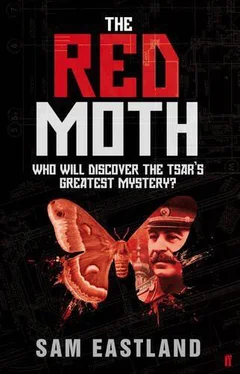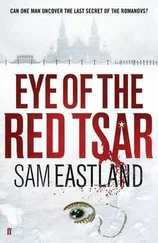Sam Eastland - Red Moth
Здесь есть возможность читать онлайн «Sam Eastland - Red Moth» весь текст электронной книги совершенно бесплатно (целиком полную версию без сокращений). В некоторых случаях можно слушать аудио, скачать через торрент в формате fb2 и присутствует краткое содержание. Жанр: Исторический детектив, на английском языке. Описание произведения, (предисловие) а так же отзывы посетителей доступны на портале библиотеки ЛибКат.
- Название:Red Moth
- Автор:
- Жанр:
- Год:неизвестен
- ISBN:нет данных
- Рейтинг книги:3 / 5. Голосов: 1
-
Избранное:Добавить в избранное
- Отзывы:
-
Ваша оценка:
- 60
- 1
- 2
- 3
- 4
- 5
Red Moth: краткое содержание, описание и аннотация
Предлагаем к чтению аннотацию, описание, краткое содержание или предисловие (зависит от того, что написал сам автор книги «Red Moth»). Если вы не нашли необходимую информацию о книге — напишите в комментариях, мы постараемся отыскать её.
Red Moth — читать онлайн бесплатно полную книгу (весь текст) целиком
Ниже представлен текст книги, разбитый по страницам. Система сохранения места последней прочитанной страницы, позволяет с удобством читать онлайн бесплатно книгу «Red Moth», без необходимости каждый раз заново искать на чём Вы остановились. Поставьте закладку, и сможете в любой момент перейти на страницу, на которой закончили чтение.
Интервал:
Закладка:
Elizaveta raised the paper bag. ‘I brought you some lunch, but I can’t stay. Sergeant Gatkina. .’ Before she could continue, the phone rang.
‘I have to answer that,’ said Kirov.
‘I should be going, anyway,’ she told him, as she set the paper bag and the thermos on his desk.
‘No,’ Kirov told her. ‘Stay. Please stay. To hell with Sergeant Gatkina. Have lunch with me. I’m sure this call will only take a minute.’ He lifted the receiver and pressed it to his ear.
‘Hold for Comrade Stalin!’ Poskrebychev’s shrill command drilled into Kirov’s head.
There was a rattling at the other end. ‘Do you think it’s true?’ Stalin’s voice echoed down the line. ‘Do you really believe he is dead?’
‘No, Comrade Stalin.’
‘Neither do I,’ replied Stalin.
‘But if Pekkala’s still alive,’ Kirov countered, ‘then where could he possibly be?’
‘As of this moment, Major Kirov, it’s your job to answer that question. Find Pekkala. Bring him back to Moscow.’ Then the lines went silent as Stalin slammed down the receiver.
With Stalin’s voice still ringing in his ears, Kirov hung up the phone.
‘What did he want?’ asked Elizaveta.
‘He has ordered me to find Pekkala.’
‘But he’s dead! They already found his body!’
‘They found a body‚ yes‚ but the corpse was badly burned.’
‘Then how do you explain the gun? Or his passbook?’
‘I can’t. I just don’t believe he is dead.’
‘What are you saying? That he faked his own death? Why would he do that?’
‘I don’t know.’ Kirov stared out across the rooftops of the city, to where the golden spires of the Kremlin gleamed in the afternoon sun. ‘But if he is alive out there‚ I’ll find him.’
The Amber Room: Timeline
1701 — Prussian sculptor Andreas Schluter, working with Danish ivory cutter Gottfried Wolfram, creates plans for the construction of the Amber Room by the Danzig Amber Guild. The idea is approved and funded by King Friedrich I of Prussia, with the intention of installing it at his Palace in Berlin.
1716 — Friedrich Wilhelm I, son of Friedrich I and known as the Soldier King, gives the Amber Room to Russian Tsar Peter I, as part of an exchange of gifts to celebrate a diplomatic treaty between the two countries.
13 January 1717 — The Amber Room arrives in St Petersburg. Peter I is unable to reassemble the structure, so it is stored in boxes in the cellar of the Winter Palace.
1717 — Empress Catherine I of Russia orders construction of the Catherine Palace as a summer residence in Pushkin, then known as Tsarskoye Selo.
1755 — Catherine the Great orders the Amber Room to be installed in the Catherine Palace.
1763 — Installation of the Amber Room in Catherine Palace is completed under the direction of Italian architect Carlo Rastrelli.
22 June 1941 — German invasion of Soviet Union, codenamed Operation Barbarossa, begins.
24 June 1941 — Palace treasures are being packed in any available container, including the former Tsar’s luggage and, in some cases, padded with pieces of the Tsar and Tsarina’s clothing.
30 June 1941 — rail wagons containing treasure from the Catherine and Alexander Palaces depart for Siberia. Under the direction of Anatoli Urbaniak, Soviet official responsible for the evacuation of art and treasure from Pushkin, the Amber Room is concealed under layers of gauze and wallpaper.
24 August 1941 — The walls of the Catherine and Alexander Palaces are bare.
28 August 1941 — German Army units 10 km south of Leningrad.
1 September 1941 — Leningrad burns.
13 September 1941 — Pushkin under fire from German artillery.
17 September 1941 — Fighting between German and Soviet troops on grounds of Catherine and Alexander Palaces.
19 September 1941 — Soviet troops withdraw from Pushkin.
c. 21 September 1941 — The Amber Room is located by German army units under the command of Colonel Count Solms-Laubach.
c. 30 September 1941 — General Erich Koch orders the Amber Room to be dismantled and moved to the Prussian Fine Arts Museum in Konigsberg, where it is to be placed in the care of Dr Alfred Rohde, director of art collections in the Konigsberg Castle Museum.
c. 10 November 1941 — The Amber Room, packed into crates, arrives in Konigsberg.
1942-44 — The Amber Room is put on public display in the Konigsberg Royal Castle Museum.
March 1944 — Pushkin retaken by Soviet Army.
1 April 1945 — The Amber Room is packed into crates in the Knights Hall of Konigsberg Castle. Plans have been made to transport the Amber Room to Saxony in central Germany, away from the Soviet advance, but by the time all arrangements have been made, no trains are available for transporting the crates.
9 April 1945 — Soviet troops (artillery regiment) occupy Konigsberg Castle.
10 April 1945 — General Otto Lasch surrenders the city of Konigsberg to Soviet Army.
11 April 1945 — Konigsberg Castle burns. Fires may have started as early as 9 April.
13 April 1945 — Despite extensive searches in Konigsberg, Soviet troops are unable to find the Amber Room.
1945-present — Numerous subsequent investigations, both unofficial and those sponsored by the Soviet and East German governments, have failed to locate the Amber Room.
Many theories exist as to the fate of the Amber Room:
— It was destroyed by Allied bombing of Konigsberg in April of 1945.
— It was destroyed when the castle burned, leaving behind only a fine residue of ash, since amber is a resin and combusts at a relatively low temperature. It has been suggested that Soviet authorities did not realise that ash found in the location where the amber was thought to be hidden was in fact the remains of the Amber Room.
— It was loaded on to a ship leaving the port of Gadynia in 1945, but the ship was sunk by Russian submarines patrolling the Baltic.
— It was loaded into watertight containers on board an unmanned submarine with a limited fuel supply and sent into the Baltic. When the submarine ran out of fuel, it came to rest on the seabed.
— The amber was brought to Wildtenkend salt mine in Volpriehausen, Germany, and was either buried in an explosion there or was discovered by American troops and looted.
— It is hidden in a silver mine 100 km south of Berlin.
— It is buried in a lagoon near the town of Neringa in Lithuania.
— It is hidden in the Orinoco river in Venezuela.
1983 — German cabinet maker Johann Enste discovers a chest which was once part of the Amber Room inventory.
1992 — German police detain Hans Achtermann, son of a former German officer, on suspicion of trying to sell, through an art dealer named Keiser, one of the Florentine mosaics which once decorated the Amber Room. The officer had been a member of the German army cadre responsible for moving the Amber Room from Pushkin to Konigsberg.
31 May 2003 — At a cost of $11,350,000, the New Amber Room, a twenty-year-long reconstruction of the original, involving over 500,000 pieces of amber weighing more than six tons, funded in part by a $3.5 million donation from the German company Ruhrgas, is unveiled as part of the 300th anniversary celebrations of St Petersburg (formerly Leningrad). The Amber Room continues to receive thousands of visitors each year.
Интервал:
Закладка:
Похожие книги на «Red Moth»
Представляем Вашему вниманию похожие книги на «Red Moth» списком для выбора. Мы отобрали схожую по названию и смыслу литературу в надежде предоставить читателям больше вариантов отыскать новые, интересные, ещё непрочитанные произведения.
Обсуждение, отзывы о книге «Red Moth» и просто собственные мнения читателей. Оставьте ваши комментарии, напишите, что Вы думаете о произведении, его смысле или главных героях. Укажите что конкретно понравилось, а что нет, и почему Вы так считаете.











